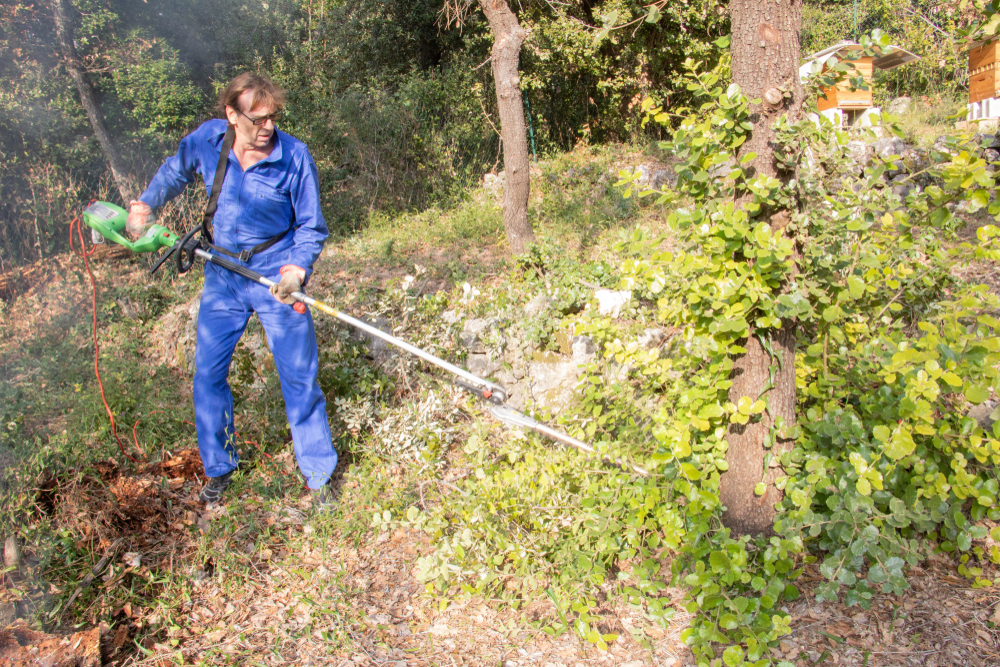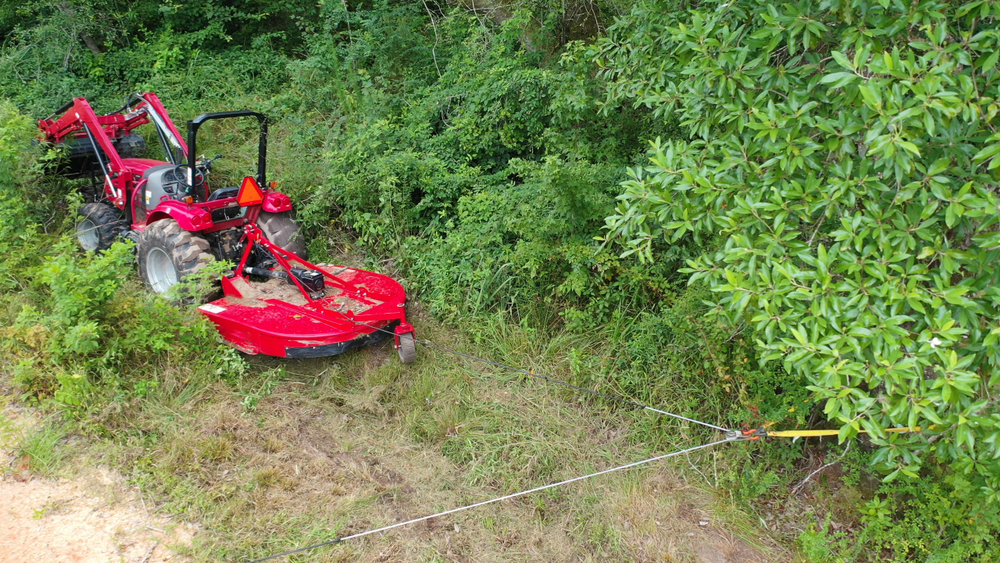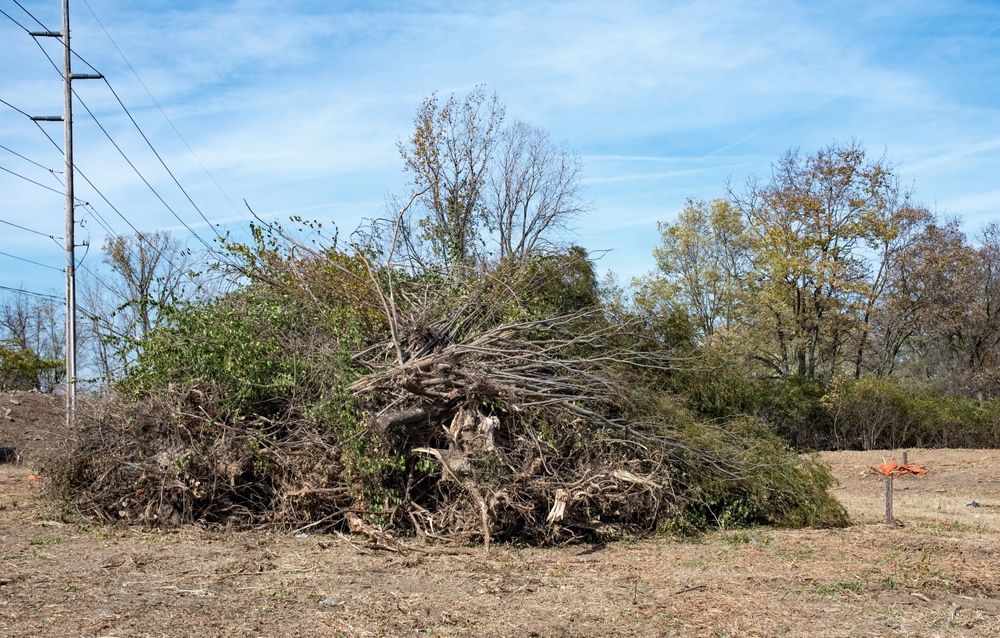February 15, 2024 - Benjamin Ehinger
Brush Clearing Essentials: Effective Techniques for Land Management
CALL NOW 844-762-8449
Clearing brush from your yard not only enhances its appearance but also promotes a healthier landscape. Engaging in this activity can reduce the risk of fire, control unwanted plant growth, and create space for new plants or landscaping projects. However, it’s vital to understand that brush clearing can be labor-intensive and requires careful planning. There are various techniques and tools designed for efficient brush removal, ranging from manual tools like pruners and saws to more heavy-duty equipment like brush mowers and chainsaws.
When undertaking brush clearing, it’s essential to have a strategy for disposing of the debris. Renting a yard waste dumpster is one effective way to manage the brush as you clear it, ensuring your property remains tidy and reducing trips to the disposal site. Before you begin cutting and clearing, be aware of local regulations and obtain any necessary permits to avoid potential fines and ensure an environmentally responsible approach.
 When clearing brush, your plan of attack will depend greatly on the size and type of vegetation. Choosing the right method, whether manual or mechanical, can greatly enhance your efficiency and safety.
When clearing brush, your plan of attack will depend greatly on the size and type of vegetation. Choosing the right method, whether manual or mechanical, can greatly enhance your efficiency and safety.
 When you clear brush from land, you are altering the ecosystem. Understand the habitat considerations and the importance of soil conservation to minimize negative impacts.
When you clear brush from land, you are altering the ecosystem. Understand the habitat considerations and the importance of soil conservation to minimize negative impacts.
Key Takeaways
- Effective brush clearing improves yard health and reduces fire risks.
- Appropriate disposal, such as using a yard waste dumpster rental, streamlines the clearing process.
- Awareness of local environmental guidelines is crucial before commencing brush removal.
Brush Clearing Basics
Brush clearing is essential for maintaining a healthy, safe, and aesthetically pleasing landscape. It involves removing unwanted vegetation such as bushes, shrubs, and overgrown plants from your land.Tools and Equipment
For effective brush clearing, you need the right tools and equipment. Basic hand tools include:- Brush Grubbers: Ideal for pulling out small trees and shrubs by the roots.
- Pruning Saws: Useful for cutting through branches and thick brush.
- String Trimmers: Best for trimming grass and small weeds.
- Brush Mowers: These are powerful and can quickly clear large areas of dense brush.
- Chainsaws: Essential for cutting down larger trees and thick branches.
- Stump Grinders: Help to remove tree stumps, making the area suitable for other uses.
Safety Considerations
Your safety is paramount during brush clearing. Wear protective gear:- Gloves: Protect your hands from cuts and blisters.
- Safety Glasses: Shield your eyes from flying debris.
- Ear Protection: For operating loud machinery.
- Long Pants and Sleeves: To minimize skin exposure to thorns and insects.
Planning and Preparation
Effective brush clearing begins with thorough planning and preparation. By assessing your land and understanding legal requirements, you’ll set the foundation for a successful project.Assessing the Land
Before you start, closely examine the area you plan to clear. Identify the types of vegetation, such as small, young trees, vines, or dense underbrush. Determine what equipment will be necessary, like a brush cutter for thinner vegetation or a chainsaw for larger trees. Take note of the land’s topography; steep slopes or uneven ground may require specialized machinery or techniques.Obtaining Permits
Your brush clearing project may be subject to local regulations. Contact your local government to learn about necessary permits or restrictions, such as controlled burn guidelines or wildlife preservation laws. Ensure compliance with these rules to avoid penalties and contribute to the safety and ecological well-being of your area.Execution Techniques
 When clearing brush, your plan of attack will depend greatly on the size and type of vegetation. Choosing the right method, whether manual or mechanical, can greatly enhance your efficiency and safety.
When clearing brush, your plan of attack will depend greatly on the size and type of vegetation. Choosing the right method, whether manual or mechanical, can greatly enhance your efficiency and safety.
Manual Clearing Methods
- Hand Tools: For smaller jobs, you can use hand tools such as billhooks to slice through brush and uproot shrubs. Pruning shears are ideal for cutting smaller branches, while a sturdy leaf rake can help you collect and dispose of debris.
- Safety Gear: Always wear gloves, goggles, and long sleeves to protect your skin from thorns and your eyes from flying debris.
Mechanical Clearing Methods
- Power Tools: When dealing with larger areas or tougher vegetation, power tools like chainsaws and brush cutters can save you time and effort. A brush cutter with a blade attachment is essential for cutting through thickets and saplings.
- Machine Maintenance: Check that all mechanical equipment is in good working order before use to avoid malfunctions and ensure a smooth clearing process.
Debris Management
Effective debris management after brush clearing focuses on safe disposal and environmentally responsible practices. It ensures you minimize your ecological footprint while keeping your property tidy.Disposal Methods
Once you’ve cleared brush, transporting the debris to a designated waste facility is a primary method of disposal. Check local regulations for waste disposal, as some areas allow burning of vegetation, while others require you to bring brush to a land-clearing debris landfill. Renting an industrial wood chipper is also an option; it can convert large volumes of brush into mulch, which some facilities may accept for a fee.- Transport to facility: hauling away to composting centers or landfills.
- Burning: where permitted, may require a permit.
- Chipping: converting brush to mulch.
Recycling and Reuse
Rather than disposing of brush, you have opportunities to recycle and make ecological use of the material. This not only conserves resources but can also save on disposal costs. By chipping brush, you can create mulch that protects soil moisture and prevents weed growth. Larger branches can be cut for firewood, and some services will take clean, untreated lumber for reuse in other projects.- Mulching: reusing chipped material on-site.
- Firewood: cutting and curing wood for personal use or sale.
- Services: donation to organizations that repurpose untreated lumber.
Environmental Impact
 When you clear brush from land, you are altering the ecosystem. Understand the habitat considerations and the importance of soil conservation to minimize negative impacts.
When you clear brush from land, you are altering the ecosystem. Understand the habitat considerations and the importance of soil conservation to minimize negative impacts.
Habitat Considerations
Brush clearing should be approached with consideration for the native wildlife whose habitats may be affected. For instance, while you might see immediate benefits such as reduced fire hazards, there is a potential to disrupt the local fauna. Careful planning can prevent the loss of biodiversity; strategies include selecting specific times for clearing that avoid nesting seasons and preserving key habitat features.Soil Conservation
The soil is a fundamental component of any ecosystem, and its preservation is vital during brush clearing. Exposed soil can lead to erosion and reduced water quality. Implementing measures like leaving root structures intact can help to maintain soil stability and health. Additionally, by choosing to let brush decompose rather than burning, you contribute less to carbon emissions and can improve soil quality with the resulting natural compost.Frequently Asked Questions
In this section, you’ll find answers to common questions about brush clearing to help you tackle your overgrown property efficiently and safely.What are the most effective tools for clearing overgrown brush?
The most effective tools for clearing overgrown brush typically include brush cutter attachments for heavy equipment as they can remove the most brush in the least amount of time. For smaller tasks, high-quality loppers, saws, and manual pruners might suffice.How big of a yard waste dumpster do I need to dispose of my brush?
Dumpster size depends on the volume of brush you need to clear. A 10-yard dumpster or 15-yard dumpster is usually sufficient for smaller projects, but larger areas may require a 20-yard dumpster to 30-yard dumpster.How much does it typically cost to clear brush from a property?
The cost for clearing brush can vary significantly based on the property’s size, brush density, and location. Professional services may charge by the hour or by the acre, and prices can range from $20 to $200 per acre.When is the ideal time of year to undertake brush clearing?
The best time of year for brush clearing is during the late winter or early spring when vegetation is dormant, and the risk of disturbing wildlife is lower. Also, conditions are less conducive to the rapid spread of fire during these periods.What should one consider when choosing a brush clearing service?
When choosing a brush clearing service, consider their experience, equipment, and approach to safety. Look for reviews or references and ensure they are properly licensed and insured.How can I safely use power tools for brush removal?
Always wear appropriate personal protective equipment and follow the manufacturer’s instructions. Be aware of your surroundings, and never operate power tools when you’re tired or under the influence of drugs or alcohol.What options are available for renting brush clearing equipment?
Many hardware and equipment rental stores offer brush clearing tools for rent. Check the equipment’s quality and ask for a demonstration to ensure you know how to operate it properly before starting your project.RECENT BLOGS
Our Reviews
Glenda Lanier Prowell
1721758635
I have ordered an 11 yard dumpster to be delivered to my house.Lonier was extremely helpful and answered all my questions. The rate was very reasonable.
Cedric Smikle
1721660395
Amber was extremely professional and courteous. She answered all of my questions and even some that I didn’t know I needed to ask.
Cait Kaider
1721243051
I highly recommend Waste Removal USA for their responsiveness and how the staff work hard to provide exceptional customer service. They have done well by us and our clients. Thank you!
Easom Family
1721223306
Louiner Pierre-Louis Is awesome! Did a great job. Will definitely be using this same company for all my dumpster needs because of his awesome customer service! Thank you!!!
tabitha Vazquez
1720539988
Wonderful and fast customer service!
LATEST BLOGS






